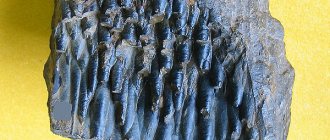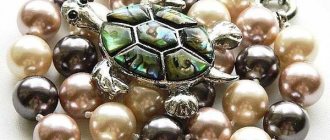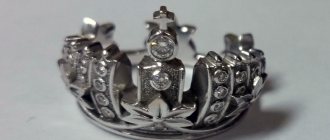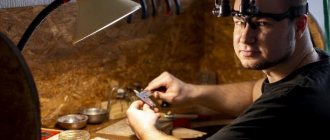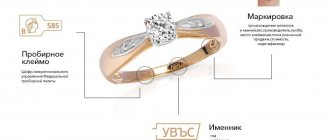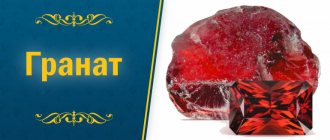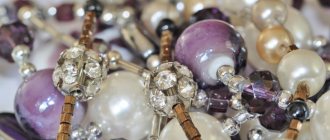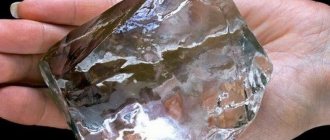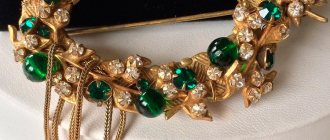Who is a jewelry 3D modeler?
The profession appeared relatively recently. 3D modelers can be called generalists. Here we have a specialist with the skills of a designer and artist. The 3D modeler is well versed in jewelry production technology, knows how to work with high-tech equipment, and the jeweler also feels confident with specific software.
It is with 3D modelers that the complex, but at the same time extremely interesting process of creating real jewelry from previously prepared sketches and layouts begins.
Course “Design and creativity in creating your own jewelry collection” from FashionFactory
| Duration | 16 lessons |
| Level | From scratch |
| Who is it suitable for? | For those who want to create jewelry, businessmen |
| Format | Video lectures (or face-to-face in Moscow) + workshops + practice + feedback from a mentor |
| Results | Certificate + projects in portfolio |
| Price | 79,000 rubles |
| Link to course | Find out details |
Content. The curriculum is divided into 3 parts and includes the following topics:
- basics of design;
- practice;
- decor.
Mentors:
Tatyana Pashutina is the founder of the New Jewelers community, creativity development coach, business coach, member of the Association of Russian-Speaking Coaches.
Irina Kuznetsova is co-founder and buyer of the online store Poison Drop.
Natalya Bodrova is the founder of the Wishing on a Star Jewelry brand.
And 3 more teachers. See the full list here.
After completing the course you will be able to:
- create a unique and successful jewelry brand;
- generate ideas;
- create sketches, transfer them to prototypes and finished products;
- develop a unique selling proposition for your target audience;
- collect models into a single collection of jewelry;
- work with materials and texture;
- calculate the cost and retail price of products;
- present the work to the customer.
My impressions: Training for both beginners and experts, which will provide the basics of design, a lot of practice and knowledge on the design of your product. To study, you will need a prototyping knife, paper, plasticine and magazines. If you take part-time training in Moscow, all these materials are provided. You will learn to develop creativity and design thinking, and will be able to develop a successful brand design strategy. These are important skills for starting a career in jewelry design!
Responsibilities of a specialist
A 3D jewelry modeling specialist faces two main tasks: digitize a sketch in three-dimensional space and create a real prototype. The specialist works closely with the artist and, if necessary, makes adjustments to the sketches with an eye to technical nuances.
The digital decoration looks like a piece of plasticine - monochrome and unremarkable. But later it can be visually transformed, which depends on the specific 3D editor. To convey the designer’s idea as accurately as possible, the 3D modeler superimposes a sketch on the image, adjusting every detail of the object .
Profession Jewelry 3D modeler
You will learn how to create 3D models of jewelry, visualize them effectively, create animations, and prepare items for printing on a 3D printer. You will learn how unique jewelry designs are created, you will be able to start a career in the jewelry business and take on private orders.
Often the artist gets involved in the layout process, adding or removing certain elements. The designer concentrates primarily on the aesthetic part of the product, while control over the technical nuances falls on the shoulders of the jewelry 3D modeler.
Each material has its own unique characteristics. Some particularly intricate designs, for example, cannot be cast in gold, while platinum or silver can be cast without any problems.
A 3D layout specialist takes into account all the nuances of the material. This includes such critical parameters as metal thickness, weight, size of precious stones, their placement around the perimeter, etc. That is, a digital jeweler takes on not only the role of a layout designer, but also a technologist.
Thus, the creation of a three-dimensional model allows you to detect possible flaws in the design in advance and adjust the calculations. To do this with a finished product is not only problematic, but also too expensive.
At the end of the modeling, the specialist begins prototyping, where the digital version of the jewelry turns into a real model . The key tool in this matter is a 3D printer. To visualize jewelry, either wax or polymer techniques are used.
Before the advent of 3D printers, designers made designs by hand. This procedure is quite tedious and time-consuming. A model made using a 3D printer is a complete analogue of a digital model. This approach allows us to identify critical flaws that are almost impossible to notice in hand sketches.
The model made on a 3D printer is finalized and only then sent for casting. At this stage, it often turns out that the customer wanted a slightly different decoration, so the modeling and 3D printing procedure is repeated again.
It is also useful to read: Profession brand designer
Precision and quality
The positioning accuracy of the cutter in CNC machines reaches 0.001 mm, which is higher than that of a 3D printer. The quality of surface processing by a milling cutter also depends on the size of the cutter itself, and the radius of the tip of the cutter is at least 0.05 mm, but the movement of the cutter is programmed, usually a step of a third or half of the cutter, respectively - all transitions are smoothed out.
Photo by @freemanwax
The layer thickness when printing on the Form 2, the most popular but far from the most accurate printer, and therefore the vertical accuracy, is 0.025 mm, which is half the diameter of the tip of any cutter. Its beam diameter is 0.14 mm, which reduces resolution but also produces a smoother surface.
Photo @landofnaud
In general, the quality of the resulting products on a photopolymer printer and top-end milling machines is comparable. In some cases, on simple forms, the quality of the milled part will be higher. With the complexity of shapes, the story is different - a 3D printer is capable of printing something that no milling cutter could ever cut, due to design limitations.
Who can become such a specialist?
First of all, a specialist must have technical skills, and only then creative ones. In a good half of cases, the artist takes on the design of the sketch, not the 3D modeler. While the latter plays the role of a layout designer-technologist.
A specialist must have an understanding of metals and stones , from external qualities to the unique properties of a particular material. A 3D modeler needs a good technical base. Communication skills also do not hurt, because a specialist, on duty, has to communicate with the customer, artist and production workshop staff.
How does this happen
The printed models are soldered to a wax barrel, then the resulting structure is filled with plaster or a special solution, after hardening of which the finished form is heated in an oven and then filled with metal.
The wax material burns out without a trace, allowing the metal to take up all the free space and exactly repeat the shape of the workpiece.
More details:
1. The casting process begins with printing the model and standard post-printing processing - the printed part is separated from the supports, washed, subjected to curing exposure in ultraviolet light, and, if necessary, lightly polished.
2. Next, the process is similar to that used for casting using conventional waxes. The blanks are soldered to a wax sprue, which will hold them in the correct position and create a channel for metal distribution.
If the quantity and size of the products allow, you can skip this step - if you print the products together with the sprue as a single unit.
3. The sprue is fixed in the injection flask. If the flask is perforated, the holes should be closed, for example, with packing tape.
4. The filling solution is mixed in the proportions specified class=”aligncenter” width=”1000″ height=”513″[/img] Then it is poured into the flask with the sprue inside. Pour carefully so as not to damage the model or dislodge the tree.
5. The flask is placed in a vacuum chamber for at least 90 seconds so that all the air comes out of the solution. Then it is transferred to a place protected from vibration to allow it to harden as quickly as possible.
6. Molded containers are placed in an oven, cold or heated to 167ºC, and the temperature is gradually raised until the plastic of the models is completely burned out.
Preheat - preheating.
Insert flask - place the flask in the oven. Ramp — raise (change) the temperature. Hold - hold the temperature (example: 3h = 3 hours) 7. Upon completion of this process, metal is poured into the mold.
8. After filling, the mold is cooled and the filling material is washed out.
9. All that remains is to remove the finished products, separate them and lightly polish them.
Photos of products created by Top3DShop:
Where to get an education
You can get a good foundation at a university or college. The most common direction is “Decorative and Applied Arts” (index 54.03.02). The duration of training depends on the degree and format of the educational institution - from 4 to 6 years.
Popular universities for mastering a specialty:
- RSU named after A.N. Kosygina;
- Moscow Regional University (MSOU);
- MSPU;
- RA of painting named after. I. Glazunova;
- MGHPA named after. S.G. Stroganov.
For those who decide to get acquainted with the profession without leaving their main place of work, online courses are perfect. The Skillbox platform is a confident leader in the distance learning market. The program consists of 5 courses and is designed for both beginners in this business and specialists who want to improve their level.
Training program:
- Jewelry design in 3D. Mastering cutting, fastenings and studying the key qualities of jewelry materials. Creation of 3D models in the Rhinoceros program.
- Renders. In-depth study of specific KeyShot and Photoshop software for effective project visualization.
- Budget calculation. Determining the cost of a future piece of jewelry.
- Complex modeling. Non-standard cut, original shapes, pavé setting in the Grasshopper program.
- Preparing the model for 3D printing. Selecting a printer by print type. Finding defects in jewelry using the Materialize Magics utility.
Training takes place in a classic format for online courses. The topic is studied - theory and practical lessons, then completing assignments and working with a teacher, where mistakes are corrected and basic knowledge is consolidated. Based on the results of the courses, defense of the thesis.
The Skillbox platform offers payment in installments for 24 months . There are often significant discounts, where the cost of training is reduced, for example, from 7 to 4 thousand rubles per month.
Jewelry Modeling Course from Jewel Courses
| Duration | 1–2 months |
| Level | From scratch |
| Who is it suitable for? | For beginning jewelers, beginners |
| Format | Online lectures + homework + feedback from the mentor |
| Results | Certificate + project in portfolio |
| Price | 12,000 rubles |
| Link to course | Find out details |
Content. The curriculum includes the following lesson topics:
Teacher:
Mikhail Rachinsky is a teacher, jewelry designer.
After completing the course you will be able to:
- use the Blender 3D modeling package;
- master the basics of jewelry making;
- build stages of product development;
- come up with design ideas;
- grow a wax model on a 3D printer;
- master the technological requirements of jewelry production.
My impressions: The course is divided into 3 parts, each of which provides important knowledge. In the first, you study tools, in the second, 3D modeling, and in the third, organizing your own work and jewelry production technology. All this is needed to fully understand it. how jewelry is created. Thanks to this knowledge, you can find your first clients and start earning money!
First experience
It is very difficult for a university graduate to receive a real order, not to mention those who have completed online courses. Customers in this segment are quite demanding and fastidious and want to see an experienced specialist in the role of performer.
The best option for a beginner is to work as an apprentice 3D modeler. Busy professionals always need help with routine tasks. The payment may not be the most attractive, but access to serious orders, as well as gaining experience, eliminates the financial side of the issue. Several real works in your portfolio will allow you to reach more or less good clients.
At first, you can also work as a freelancer. On specialized exchanges there are always entry-level orders for 3D modeling. Having gotten your hands on simple projects, you can move on to more complex ones or get an offline job.
Options
Work can be organized in many ways. Typically, a computer file with a three-dimensional image of a craft is saved in a format readable by almost all modern programs and sent for jewelry prototyping. There, a real sample of the future decoration is produced, which you can touch with your hands.
Sometimes a modeler has to work with a program with a recently updated interface or save a file in a format that not every software can read. Then the work time may increase by a couple of days. However, they still do not exceed several days.
Wage
Here, a lot depends on the skills the specialist has and the type of employment. In mediocre jewelry stores and studios, a university graduate can count on a salary of 30-40 thousand rubles per month. A 3D modeler with 3 years of experience earns about 60,000 .
The situation in freelancing is approximately the same. For example, customers are willing to pay about 2-3 thousand rubles for a digital sketch of a suspension. A model of ring, earrings and necklace costs about 7-10 thousand. The remuneration of seasoned professionals in this field as such does not have an upper limit.
Conclusions:
Both technologies have their pros and cons.
If the jewelry workshop already has a CNC milling machine, then it will cope with most of the tasks of producing single pieces. Moreover, if only single copies are made and not very often, then the machine wins in speed. If the goal is not to develop production, increase the volume of work, turnover of funds, or raise the level of complexity of products, then a 3D printer will only be an additional financial burden.
With an increase in the pace and volume of work, with the constant introduction of new models, the advantages of a 3D printer will become noticeable immediately; in mass production, the difference in speed is serious. The printer can hardly be overestimated in rapid prototyping and production of batches of blanks.
If the enterprise carries out both types of orders - both single and serial - it will be more efficient and economically feasible to have both devices on the farm, for different types of work, they will organically complement each other.
Pros and cons of the profession
This is a relatively new and actively developing area: the demand for jewelry 3D modelers significantly exceeds the supply. And as a result, an increased rate. Beginning specialists earn 20-30% more than ordinary designers.
Another significant plus is the possibility of remote work . A digital version of a piece of jewelry can easily be made by a performer, for example, from Yekaterinburg for a customer from Krasnodar. There are more than enough specialized freelance exchanges on the Internet.
One of the significant disadvantages of the profession is the customer’s capriciousness and excessive demands. Sometimes he himself doesn’t know what he wants, sifting out option after option. That is, the performer often has to guess the customer’s wishes, taking into account his intuition and experience rather than the meager wishes of the latter.
Jewelry workshop
Website: https://masterskaya-ukrashenij.ru Phone: Cost: from 9850 rub. per course
Step-by-step practical online course.
Course participants:
- Get access to the training platform and feedback from an expert
- Using video lessons, they learn to understand the styles and types of jewelry
- Learn to select them correctly for individual characteristics
- They sort out their jewelry boxes and create new, trendy combinations.
- Mastering a new direction - Jewelry Stylist
- Analyzing the box for the first client
- Learn how trends form and learn to track them
- Receive a certificate of completion of the course
- Get the opportunity to earn extra money by providing your services
Academy of Jewelry Arts
Website: https://acadgold.ru Cost: free
Free and accessible online course "Jewelry". By completing this course, you will take the first step towards serious learning and will be able to clearly determine the direction of your interests! You can also study other interesting online courses for free. Register and gain knowledge completely free of charge.
